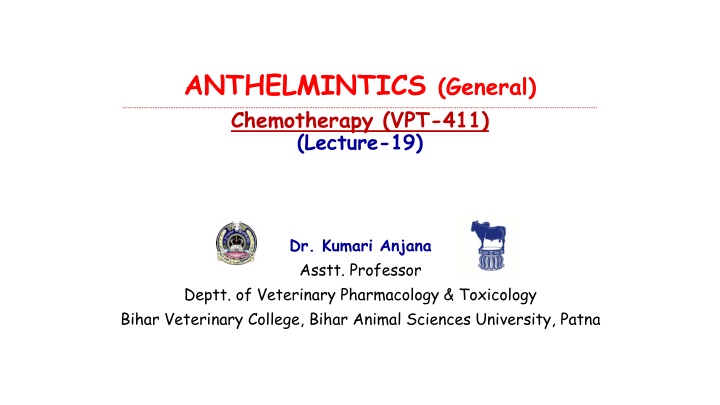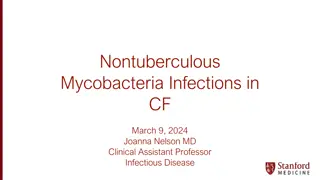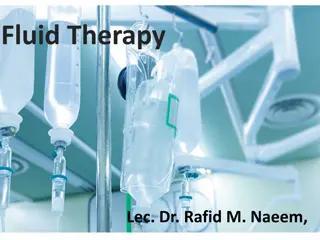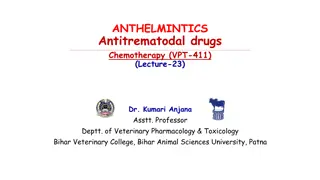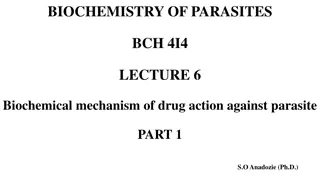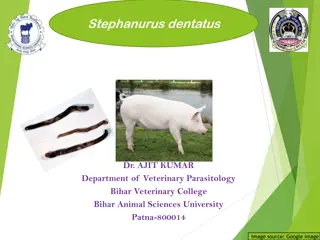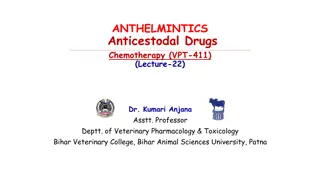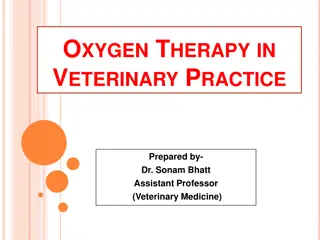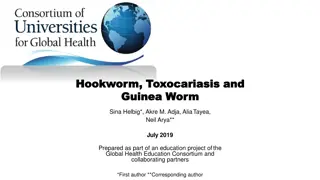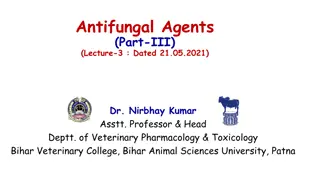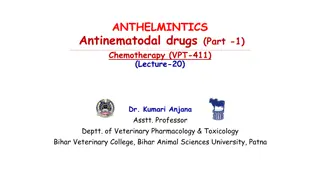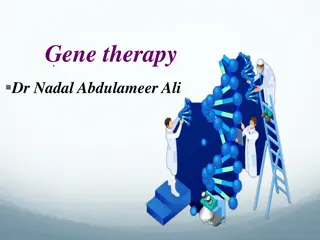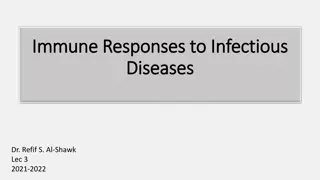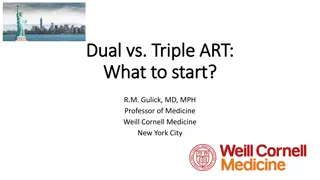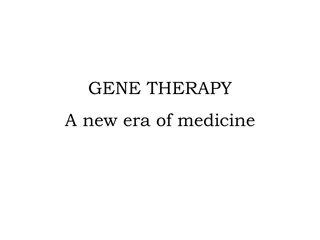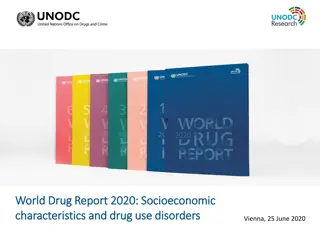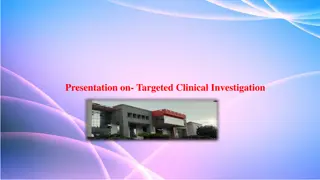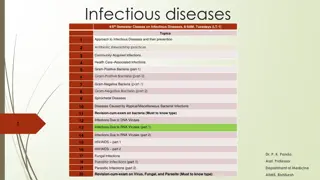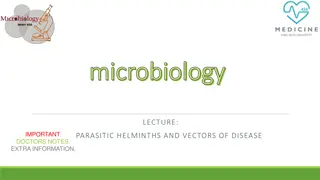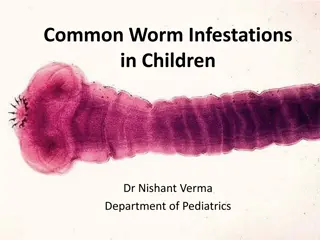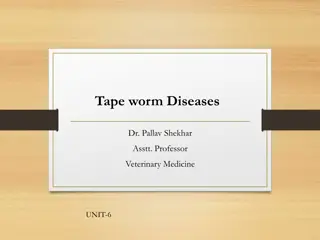Anthelmintics: Drug Therapy for Parasitic Worm Infections in Veterinary Medicine
Anthelmintics are essential drugs to combat parasitic worm infections in animals. They work either by killing (vermicide) or expelling (vermifuge) the worms, reducing worm burdens and controlling infections. This comprehensive overview covers different aspects of anthelmintics, including their properties, classification based on mode of action, and details about helminths such as nematodes and flatworms. Learn how these drugs are utilized in veterinary medicine to treat chronic and acute infections effectively.
Download Presentation

Please find below an Image/Link to download the presentation.
The content on the website is provided AS IS for your information and personal use only. It may not be sold, licensed, or shared on other websites without obtaining consent from the author.If you encounter any issues during the download, it is possible that the publisher has removed the file from their server.
You are allowed to download the files provided on this website for personal or commercial use, subject to the condition that they are used lawfully. All files are the property of their respective owners.
The content on the website is provided AS IS for your information and personal use only. It may not be sold, licensed, or shared on other websites without obtaining consent from the author.
E N D
Presentation Transcript
ANTHELMINTICS (General) Chemotherapy (VPT-411) (Lecture-19) Dr. Kumari Anjana Asstt. Professor Deptt. of Veterinary Pharmacology & Toxicology Bihar Veterinary College, Bihar Animal Sciences University, Patna
Content of the chapter Introduction to Anthelmintic Introduction to Helminths Properties of Ideal Anthelmintic Classification on the basis of MOA
Introduction Anthelmintic are drugs used to either kill (vermicide) or expel (vermifuge) the parasitic worms or helminths that inhabit GI tract and other tissues and organs of the body. Vermicide: When Anthelmintic kill the parasitic worms. Vermifuge: When Anthelmintic remove the parasitic worms from GI tract by temporarily paralysing them they are called vermifuses. In this case purgation is required for elimination of worms. Widely used in veterinary medicine both prophylactically and to treat chronic and acute infections. They help to reduce worm burdens and control worm larvae on the pasture or eggs in the environment.
Helminths Helminths (Greek word helmins or helminthos = a worm) are internal parasites of animals and birds. They mainly belong to two important phyla: Nemathelminthes Platyhelminthes (roundworms (flukes, tapeworms, and other flatworms). and their relatives) Helminths typically parasitize vertebrates, although invertebrates such as arthropods and molluscs act as intermediate hosts.
Helminths mainly infect GI tract and associated structures, but they can be found in other parts of the body as well. Helminths in most cases cause only discomfort and ill health without mortality. In some cases, excessive blood loss, injury to vital organs intestinal or lymphatic obstruction, or secretion of toxins by helminths endanger life of animals.
Phylum nemathelminthes The phylum Nemathelminthes consists of an important class Nematoda. The nematodes, commonly called roundworms are unsegmented, cylindrical worms with a resistant cuticle. With a few exceptions, the sexes are separate and the lifecycle may be direct or indirect with an intermediate host. The nematode form a large and complex group of endoparasites consisting of several orders.
Phylum Platyhelminthes The phylum Platyhelminthes consists of two important classes of animal parasites Cestoda (tapeworms) & Trematoda (flukes).
Cestoda (Tapeworms): The cestodes or tapeworms are elongated endoparasites with flat body. The body consists of a head or scolek, a neck, and a strobila consisting of a number of segments or proglottids. Each proglottid usually contains one or two sets of reproductive organs. The tapeworms are hermaphrodite. They require two or more hosts for completion of their life cycle. Almost all tapeworms of veterinary importance belong to the order Cyclophyllidea, with two exceptions Pseudophyllidea. being in the order of
Trematoda : The trematodes (flukes) are leaf like, unsegmented, dorsoventrally flattened endo- or ecto-parasites. Their body usually contains suckers, hooks, or clamps that attach these parasites to exterior or internal organs of their host. Their life cycle, like those of tapeworms, involves more than one host.
Ideal Anthelmintic Should have high efficacy: oAn ideal anthelmintic should have high level of anthelmintic activity. oThe efficacy is said to be good if it removes 95% of a gastro- intestinal nematodes from ruminant spp. oIf it removes only 70% of the worm burden it is considered as a poor anthelmintic. oIt should have effect on both adult and larval stages of worms. oIf it is effective only against adult worms it is repeated to eliminate adult worms that were unaffected during the first dose. o100% removal of worm load also eliminates the source of antigenic stimulation and animal looses the acquired resistance to parasite.
Broad spectrum of activity: o The anthelmintic compound should have activity against both mature and immature parasites including larvae. Wide therapeutic index: o The anthelmintic compound should possess wide therapeutic index so that minor variation in calculation of dosage should not produce any toxicity in host. o Since, the parasite and host shares some of the similar metabolic reactions and it may be the target for many drugs. o Anthelmintic are much safer for hosts when their mechanism of action and biochemical pathways of worms do not share mutually.
Easy to administer : o It should be easily administered to large number of animals. o Most of the anthelmintic are administered orally in empty stomach. o However, some of the anthelmintic Ivermectin, ancylol etc. are administered parenterally e.g. Should be economic. Residue : It should be eliminated from the body without any residual problems. The anthelmintics possessing a long withdrawal time will create human health hazards after consumption of milk, meat and other animals produce. The anthelmintics having a short withdrawal time are much safer.
Classification of Anthelmintics Based on type of helminthes against which they are effective. Antinematodal drugs: Drugs effective against nematodes or roundworms (R). Anticestodel drugs: Drugs effective against the cestodes or tapeworms (T). Antitrematodal drugs: Drugs effective against the trematodes or flukes (LF).
General Mode of Action of Anthelmintics Most anthelmintic can be classified into two major categories on the basis of their mechanism of actions. Drug affecting the energy production of the parasites Drugs Affecting and Neuromuscular System of the Parasites, (Paralysis) o o
Drug affecting the energy production of parasites Biochemical reactions associated with the energy production of the parasites are the most important sites of drug action. On the basis type of biochemical anthelmintic are grouped as reactions interrupted the o Inhibitors of fumarate reductase enzyme and mitochondrial reactions. o Inhibitors of tubulin polymerization and glucose uptake. o Inhibitors of electron transport mediated oxidative phosphorylation in the mitochondria of the parasites. o Inhibitors of glycolysis.
Inhibitors of fumarate reductase enzyme and mitochondrial reactions: oSome drugs inhibit fumarate reductase enzyme action, thus block the generation of ATP and resulting in muscular paralysis and eventual death of the parasite. Benzimidazoles (except triclabendazole), benzimidazole pro-drugs, levamisole, bithionol, hexachlorophene. mebendazole, flubendazole and
Inhibitors of tubulin polymerization and glucose uptake: Drugs bind to free beta-tubulin, Inhibiting polymerization Interfering with microtubule-dependent glucose uptake In absence of glucose Depletion of the worm's glycogen reserve Unable to produce ATP necessary for survival
oSome benzimidazoles like mebendazole and flubendazole primarily act by inhibiting glucose transport but these two do not inhibit fumerate reductase system. oThe primary site of action of cambendazole and fenbendazole is fumerate reductase inhibition. oIn addition, like mebendazole and flubendazole they also inhibit glucose transport. oHeartworm microfilaricide, dithiazanine also act by inhibiting the glucose uptake.
Inhibitors of electron transport medicated oxidative phosphorylation in the mitochondria of the parasites: These drugs interfere with the electron transport in the mitochondria and thereby inhibit the oxidative phosphorylation and generation of ATP. The fumerate is converted to succinate but ATP is not produced. These drugs are mainly effective against flukes and tapeworms. These drugs are not effective against roundworms, inspite of having similar mitochondrial phosphorylation system because the drugs cannot penetrate tissues of the intact roundworms. These drugs also uncouple oxidative phosphorylation in the mitochondria of mammals and are often fairly toxic.
Examples of Anthelmintic Salicylanilides, bithionol, disophenol, dichlorophen, hexachlorophene, niclofolan, nitroxynil, nitroscanate, bromosalans; carbontetrachloride niclosamide, clioxanide, oxyclozanide, rafoxanide, closantel, Resorantel,
Inhibitors of glycolysis: These drugs are either organic heavy metal compounds or other chemicals. Tendency to bind with the sulfhydryl (- SH) groups and Thereby alter the structure of proteins and the active sites of glycolytic enzymes (phosphoglycerate kinase and phosphoglycerate mutase) of the parasite and host. Arsenicals: Thiacetarsamide; Antimonials: Potassium antimony tartarate and stibophen and Antitrematodal sulfonamide: Clorsulon.
Drugs Affecting and Neuromuscular System of the Parasites Anthelmintics Neuromuscular system affected Inhibiting the destruction of NT or mimicking/enhancing the action of NT or antagonizing the action of NT Ultimate result is either spastic or flaccid paralysis of the parasite Paralysed parasite expelled by the normal peristaltic movement of the host.
The drugs affecting neuromuscular system are classified as below: Cholinergic agonists Anticholinesterases Muscle hyperpolarizers Potentiation of inhibitory neurotransmitters (GABA agonists). Others
Drugs Affecting and NM System of the Parasites - Causing Paralysis. 1. Cholinergic agonists: These drugs effect the neuromuscular system of the parasite. Act as cholinergic agonists: Nicotine-like action, stimulating and subsequently blocking the neuromuscular junctions. Resulting sustained muscle contraction and spastic paralysis of nematodes. Imidazothiazoles: Butamisole, tetramisole and levamisole; Pyrimidines: Morantel, oxantel and pyrantel; Quaternary ammonium compounds: Bephenium and thenium etc.
2. Anticholinesterases: o ACh is also a neurotransmitter in parasites just like in higher animals. o The enzyme AChE also present in the parasite destroys ACh and thus prevents over stimulation of smooth muscles. o These drugs cause inhibition of acetyl cholinesterase (AChE) enzyme followed constant depolarization due to accumulation of excess ACh at the neuromuscular junction. o Leads to interference with neuromuscular transmission and consequent paralysis and expulsion the parasite, through enhanced intestinal peristalsis.
3. Muscle hyperpolarizers: An anticholinergic action at the myoneural junction in worms, producing competitive or non-depolarising type of neuromuscular blockade like curarae. This results in hyperpolarization of the muscle membrane of the worm leading to flaccid paralysis, facilitating expulsion (Piperazine and avermectins). Hyperpolarization of the muscle membrane of the worm leading to flaccid paralysis, facilitating avermectins). its expulsion (Piperazine and
4. Potentiation of inhibitory neurotransmitters (GABA agonists): oThese drugs act by potentiation of GABAergic transmission (opening of chloride channels) between nerve and muscle. oPotentiation of GABA leads to hyperpolarisation of postsynaptic cells leading to interference with neurotransmission to muscles and consequent muscular paralysis. olvermectin, abamectin, doramectin, mosidectin, milbemycin oxime and also piperazine.
Other actions: 1. Drugs affecting parasite reproduction: Low level of feeding of these drugs to animals constantly inhibit the egg production of the parasites remaining in the digestive tract of the host and thereby reduce the pasture contamination by helminth eggs, an important control measure in cattle sheep management. Phenothiazine and benzimidazoles. 2. Drugs affecting the permeability of the cells and cause vacuolation of the tegument Praziqunatel and diamfenetide.
3. Drugs cause disruption of tegument of parasites: Bunamidine, epsiprantel and praziquantel. 4. Drugs act by unknown mechanism: Bitoscanate, paromomycin, phenothiazine and triclabendazole. Increased number of parasite eggs, higher establishment rates of adult worms in the host and greater number of larvae on the pasture after treatment than would occur if the parasites were susceptible to the antiparasitic drug.
Resistance Resistance to anthelmintics by the worms develops somewhat slow comparison to antibiotic resistance in bacteria. However, the development of resistance by nematodes different groups of anthelmintics is becoming widespread (resistance to benzimidazoles, levamisole avermectins by roundworms of cattle, sheep, goat and horses). Continuous use of a highly effective anthelmintic results in selective removal of the most susceptible genotypes resulting in succeeding resistant progeny.
The resistance is manifested by passage of increased number of parasite eggs, establishment rates of adult worms in the host. Greater number of larvae on the pasture after treatment than would occur if the parasites were susceptible to the antiparasitic drug. Cross-resistance may as occur between drugs having similar mode of action (benzimidazoles).
Anthelminitc resistance can be prevented by: Designing management practices to reduce exposure to parasites and to minimize the frequency of use of anthelmintics. Development of resistance can be delayed by slow rotation of different chemicals with different mechanisms of action. Planning treatment of whole herd/flock at a time. By taking proper control measures against the parasitic phase in the host at proper time and to the free living, nonparasitic stages in the environment.
Summary Anthelmintic used as prophylactically and to treat chronic and acute infections. The nematode form a large and complex group of endoparasites. The cestodes or tapeworms are elongated endoparasites with flat body. The trematodes (flukes) are dorsoventrally flattened endo- or ecto-parasites. leaf like, unsegmented, Biochemical reactions associated with the energy production of the parasites are the most important sites of drug action.
